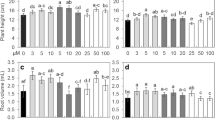Summary
The early growth of 96 genotypes of tomato was studied at 320 ppm CO2 and at 750 ppm CO2 in separate climate rooms. Plants were harvested at 40 and 55 days after sowing. Fresh and dry weights were determined. Large differences between genotypes were found for average plant fresh and dry weights and for relative growth rates. The average overall growth enhancement by CO2 enrichment was 2.3. Two genotypes showed significant genotype x CO2 interaction. The consequences of these results for tomato breeding are discussed.
Similar content being viewed by others
References
Jordan J.W. & W.L. Ogren, 1981. Species variation in the specificity of ribulose biphosphate carboxylase/oxygenase. Nature 291: 513–515.
Lasko A.N., J.F. Bierhuizen & G.F.P. Martakis, 1984. Light responses of photosynthesis and transpiration of two tomato cultivars under ambient and altered CO2 and O2. Scient. Hort. 23: 119–128.
Mortensen L.M., 1987. Review: CO2 enrichment in greenhouses. Crop responses. Scient. Hort. 33: 1–25.
Nieuwhof M., F. Garretsen & J.C.van Oeveren, 1989. Maternal and genetic affects on seed weight of tomato, and effects of seed weight on growth of genotypes of tomato (Lycopersicon esculentum Mill.). Pl. Breed. 102: 248–254.
Nilwik H.J.M., W. Gosiewski & J.F. Bierhuizen, 1982. The influence of irradiance and external CO2-concentration on photosynthesis of different tomato genotypes. Scient. Hort. 16: 117–123.
Payne R.W., P.W. Lane, A.E. Ainsley, K.E. Bicknell, P.G.N. Digby, S.A. Harding, P.K. Leech, H.R. Simpson, A.D. Todd, P.J. Verrier, R.P. White, J.C. Gower, G. Tunnicliffe Wilson & L.J. Paterson, 1987. Genstat 5 reference manual. Clarendon Press, Oxford.
Schapendonk A.H.C.M. & P. Gaastra, 1984. A simulation study on CO2 concentration in protected cultivation. Scient. Hort. 23: 217–229.
Schapendonk A.H.C.M. & W.van Tilburg, 1984. The CO2 factor in modelling photosynthesis and growth of greenhouse crops. Acta Hort. 162: 83–92.
Slack G., J.S. Fenlon & D.W. Hand, 1988. The effects of summer CO2 enrichment and ventilation temperatures on the yield, quality and value of glasshouse tomatoes. J. Hort. Sci. 63: 119–120.
Smeets L., 1986. The selektron of the Institute for Horticultural Plant Breeding (IVT), Wageningen, The Netherlands. Euphytica 35: 653–656.
Smeets L. & Garretsen F., 1985. Growth analyses of tomato genotypes under low night temperatures and low light intensity. Euphytica 35: 701–715.
Yelle S., A. Gosselin & M.-J. Trudel, 1987. Effect of atmospheric CO2 concentration and root-zone temperature on growth, mineral nutrition, and nitrate reductase activity of greenhouse tomato. J. Amer. Soc. Hort. Sci. 112: 1036–1040.
Author information
Authors and Affiliations
Rights and permissions
About this article
Cite this article
Lindhout, P., Pet, G. Effects of CO2 enrichment on young plant growth of 96 genotypes of tomato (Lycopersicon esculentum). Euphytica 51, 191–196 (1990). https://doi.org/10.1007/BF00022451
Received:
Accepted:
Issue Date:
DOI: https://doi.org/10.1007/BF00022451



